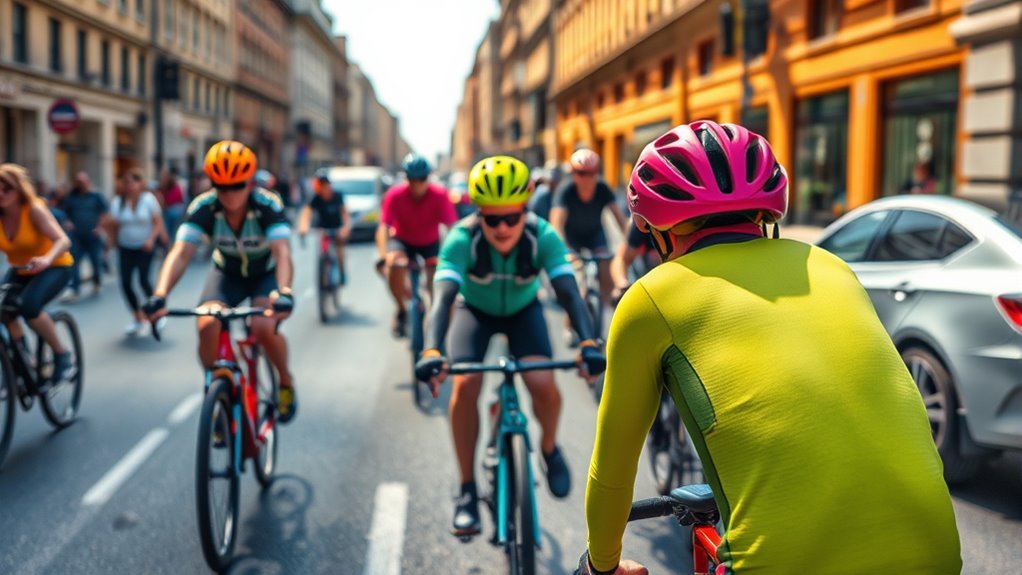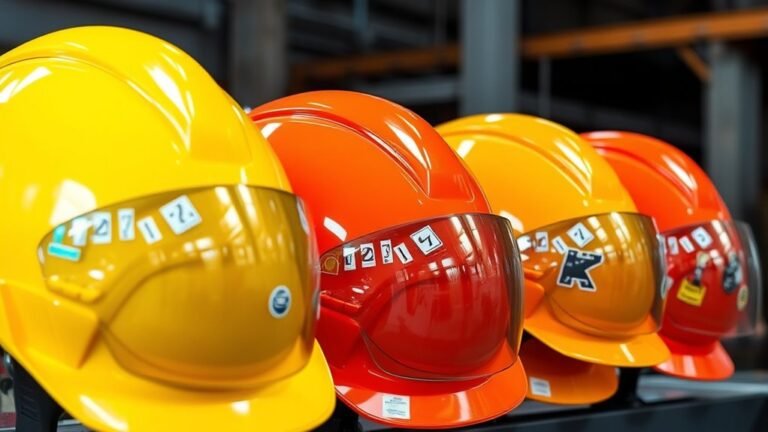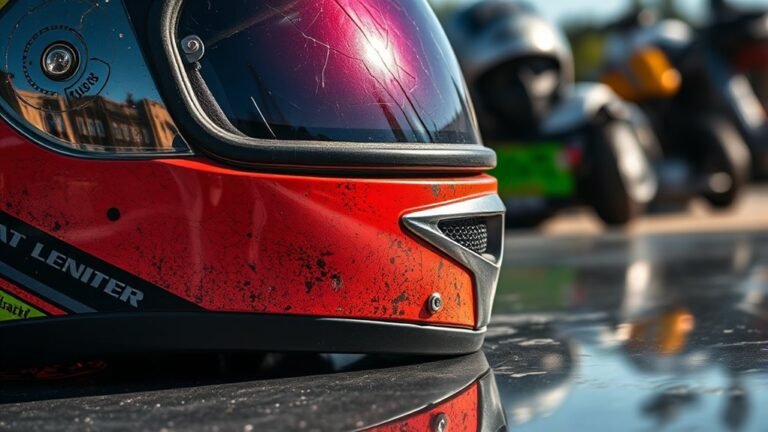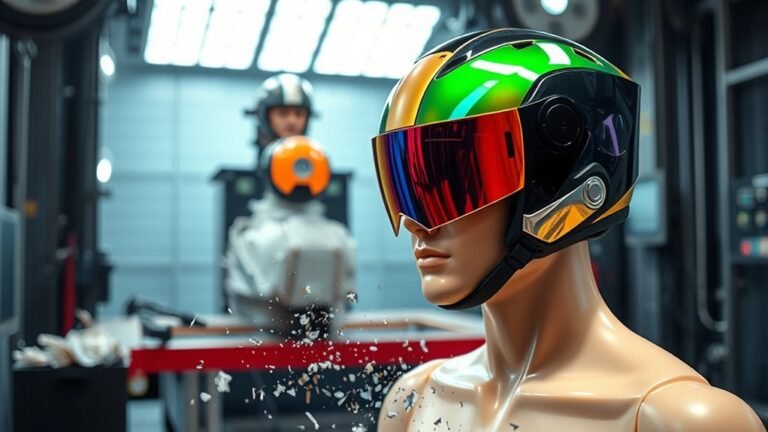How Helmet Colors Affect Visibility in Cities
Helmet colors notably affect visibility in urban environments. Bright colors, like neon yellow and orange, enhance your chances of being noticed by drivers, lowering accident risks. Psychological factors also play a role; contrasting colors grab attention and increase alertness. However, environmental elements, such as lighting and weather, can influence your helmet’s effectiveness. Choosing the right color is essential for safety. There’s more to reflect on when selecting your helmet for ideal visibility and protection.
The Importance of Visibility for Urban Riders
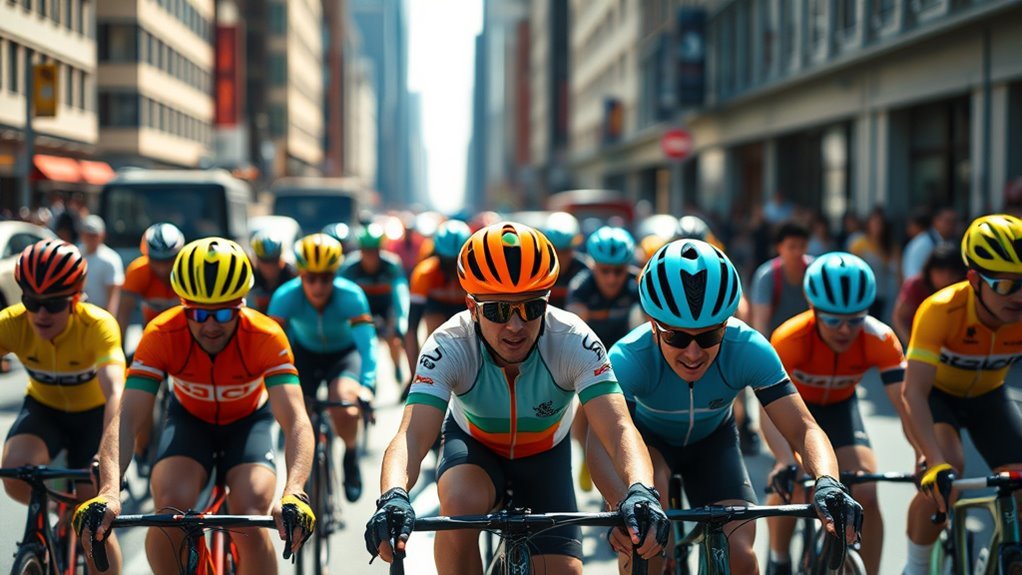
While many factors contribute to safety on urban roads, visibility stands out as an important element for riders. Enhanced visibility directly correlates with urban safety, as it allows you to be seen by motorists and pedestrians alike. Research shows that riders wearing brightly colored helmets greatly increase their chances of being noticed in traffic. This heightened visibility fosters rider awareness, enabling you to navigate complexities in urban settings more effectively. Additionally, well-lit environments and reflective gear further enhance your safety by making you more conspicuous during low-light conditions. By prioritizing visibility, you not only protect yourself but also promote a culture of awareness in urban riding—a vital step toward achieving the freedom and independence you seek on the road.
The Psychology of Color Perception

Understanding how color influences perception is essential, especially for urban riders aiming to enhance their visibility. Color associations vary widely; for example, red often signals danger, while yellow is linked to caution. These associations can drive immediate responses from motorists. However, cultural differences also play a significant role in how colors are perceived. In some cultures, white symbolizes purity and safety, while in others, it may represent mourning. This variability underscores the importance of selecting helmet colors that resonate positively across diverse urban settings. By considering these psychological factors, you can make informed choices that not only increase your visibility but also contribute to a sense of freedom on the road.
High-Visibility Colors and Their Impact
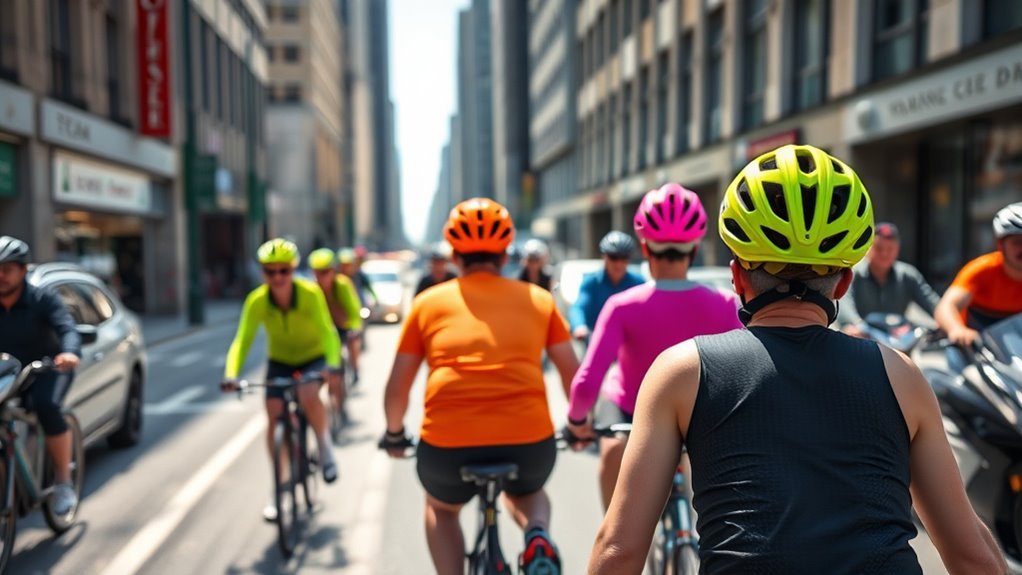
High-visibility colors like neon yellow or bright orange can greatly enhance your visibility in urban environments, especially during the day. At night, reflective materials become essential as they guarantee that lights from vehicles illuminate your helmet, making you more noticeable. Understanding the psychology behind these color choices can also inform how effectively you communicate your presence to others on the road.
Bright Colors Stand Out
Brightly colored helmets have become an essential component in urban safety for cyclists and pedestrians alike. The psychology of bright colors plays an important role in enhancing visibility, promoting urban safety awareness. When you choose a vibrant helmet, you’re not just making a fashion statement; you’re actively contributing to your safety. Here are three key reasons why bright colors stand out:
- Increased Visibility: Bright colors are more easily seen against various urban backdrops, reducing the risk of accidents.
- Psychological Impact: Colors like neon yellow or bright orange trigger alertness in drivers, prompting them to pay closer attention.
- Enhanced Recognition: Distinctive colors help you stand out, making it easier for others to recognize you in traffic.
Incorporating bright colors into your gear is a proactive step toward safer urban mobility.
Nighttime Visibility Considerations
While bright colors are effective during the day, nighttime visibility presents unique challenges for cyclists and pedestrians. At night, the ambient light diminishes, making it harder for drivers to spot you. This is where nighttime reflectivity comes into play. Helmets featuring reflective materials enhance your visibility, bouncing light back to drivers, which is essential for safety. Additionally, helmets designed to glow in the dark can provide an extra layer of awareness, ensuring you’re seen even when streetlights are scarce. By choosing high-visibility colors combined with these reflective properties, you greatly improve your chances of being noticed after sunset. Ultimately, it’s about maximizing safety while enjoying the freedom of moving through urban environments, day or night.
Color Psychology Effects
Perception plays an essential role in how colors influence behavior and safety in urban environments. High-visibility colors can greatly enhance your safety while traversing city streets. Understanding color associations and cultural perceptions can help you make informed choices. Here are three key impacts of high-visibility colors:
- Increased Awareness: Bright colors like neon yellow or orange can catch attention quickly, alerting drivers and pedestrians to your presence.
- Cultural Significance: Certain colors may evoke specific emotions or reactions based on cultural context; for example, red often signals danger.
- Behavioral Influence: Wearing high-visibility colors can psychologically boost your confidence, making you feel more secure while riding.
The Role of Environmental Factors in Visibility
When considering helmet visibility, urban lighting conditions and weather play vital roles. Poor lighting can considerably decrease visibility, even for brightly colored helmets, while adverse weather, such as rain or fog, can further obscure a rider’s presence. Understanding these environmental factors is essential for enhancing safety in urban settings.
Urban Lighting Conditions
As urban environments evolve, the interplay between lighting conditions and helmet color becomes increasingly significant for cyclists’ safety. Urban contrast can greatly influence visibility, particularly under various lighting effects. Here are three key factors to evaluate:
- Intensity of Light: Bright environments enhance the visibility of lighter helmet colors, while darker areas can obscure them.
- Type of Lighting: LED streetlights emit a cooler light, which may alter color perception compared to traditional sodium vapor lights, affecting how colors stand out.
- Surrounding Environment: Urban settings with complex backdrops can diminish the effectiveness of helmet color unless there’s a stark contrast.
Understanding these elements helps you make informed choices about helmet colors, ultimately promoting safer cycling experiences.
Weather Impact on Visibility
Urban lighting conditions greatly shape how cyclists perceive their surroundings, but weather also plays a significant role in visibility. Fog conditions can drastically reduce your ability to see and be seen, often creating a whiteout effect that makes bright colors less effective. Similarly, rain effects can lead to slick roads and reduced traction, while obscuring visibility with water droplets on your helmet or eyewear. Snow impact compounds these issues, with accumulation blocking sightlines and creating a stark contrast that can confuse drivers. Additionally, sunlight glare may momentarily blind you, making it hard to gauge distances accurately. Understanding these environmental factors is essential for enhancing your visibility and safety while cycling in various weather conditions.
Comparing Light and Dark Helmet Colors
While helmet color may seem like a minor detail, it plays a crucial role in visibility and safety in urban environments. When comparing light and dark helmet colors, consider the following factors that influence helmet color contrast and urban safety awareness:
- Brightness: Light colors reflect more sunlight, making them more visible during the day, while dark colors can blend into shadows.
- Night Visibility: Light helmets are often easier to spot at night, especially when illuminated by streetlights or car headlights.
- Psychological Impact: Bright colors can enhance the perception of safety among both cyclists and motorists, potentially reducing accidents.
Choosing the right helmet color can greatly affect your visibility, ensuring you remain safe on the roads while enjoying your freedom.
Seasonal Considerations for Helmet Color Choices
When selecting a helmet color, seasonal variations can greatly impact visibility and safety. Color preferences often shift with the seasons, influenced by factors like weather conditions and daylight hours. For instance, bright colors may stand out more against a snowy backdrop, while darker hues could blend in during fall.
| Season | Recommended Colors |
|---|---|
| Spring | Neon Green, Yellow |
| Summer | Bright Orange, Pink |
| Fall | Fluorescent Yellow, Red |
| Winter | White, Bright Blue |
Understanding these seasonal trends helps you make informed decisions that enhance your visibility. By choosing the right color for the season, you can guarantee safety while enjoying the freedom of cycling or commuting in urban environments.
Additional Gear for Enhanced Visibility
To enhance your visibility while cycling or commuting, incorporating additional gear alongside your helmet can greatly improve safety. Here are three effective options to contemplate:
Enhancing visibility while cycling is crucial; consider adding reflective accessories, lights, and bright clothing for improved safety.
- Reflective Accessories: Adding reflective vests or armbands can markedly increase your visibility, especially in low-light conditions. They reflect light from vehicles, making you more noticeable to drivers.
- Visibility Gear: Consider equipping your bike with lights, both front and rear. These lights not only illuminate your path but also alert others to your presence.
- Bright Clothing: Wearing bright, high-visibility clothing can make you stand out against urban backdrops. Opt for colors like neon yellow or orange, which are easily seen during the day.
Making the Right Choice: Tips for Selecting a Helmet
Selecting the right helmet is crucial for guaranteeing your safety while cycling in urban environments. To make an informed choice, consider essential helmet features such as impact resistance, ventilation, and weight. Look for a helmet that meets safety certifications, which indicates it can withstand significant impacts.
When it comes to fitting guidelines, confirm the helmet sits snugly on your head without causing discomfort. The chin strap should be adjustable and secure, preventing any movement during rides. A well-fitted helmet not only enhances your safety but also boosts your confidence on the road.
Lastly, don’t overlook the color; brighter shades can improve visibility. Ultimately, prioritizing these factors will help you enjoy the freedom of cycling with peace of mind.
Frequently Asked Questions
Do Helmet Colors Influence Driver Behavior Towards Cyclists?
Yes, helmet colors can greatly influence driver behavior towards cyclists. Think of a vivid sunburst cutting through clouds; bright colors enhance driver perception, making cyclists more noticeable. Color psychology suggests that bold hues like neon yellow or orange can evoke heightened alertness in drivers, prompting them to exercise greater caution. In turn, cyclists wearing these colors may experience fewer near-misses, leading to a safer riding environment and promoting a sense of freedom on the roads.
Are Certain Colors More Effective in Low-Light Conditions?
Yes, certain colors are indeed more effective in low-light conditions. Studies in color psychology suggest that brighter colors like neon yellow or orange enhance low light performance, making you more visible to drivers. These colors reflect more light, which can be vital during dawn or dusk. By choosing these shades, you’re not only prioritizing your safety but also embracing the freedom to ride confidently, knowing you’re more noticeable in challenging conditions.
How Do Weather Conditions Affect Helmet Visibility?
Weather conditions greatly impact helmet visibility. For instance, fog, rain, and snow can obscure your helmet’s color, reducing adherence to visibility standards. Dark, overcast days especially diminish contrast, making bright colors more effective. Additionally, consistent weather patterns can dictate the necessity for reflective materials. When choosing a helmet, consider how varying conditions might affect your visibility, ensuring you remain safe and easily seen regardless of the environment you find yourself in.
What Color Combinations Work Best for Urban Environments?
You’d think bright colors would always be best in urban environments, but urban color psychology suggests otherwise. A visibility contrast analysis reveals that combinations like white and neon green or dark blue and fluorescent yellow actually enhance visibility. These pairings create a balance between standing out and blending in, allowing you to ride freely while staying safe. So, embracing certain color combinations can be both a fashion statement and a smart safety choice.
Can Reflective Materials Enhance Helmet Visibility Beyond Color?
Yes, reflective materials can markedly enhance helmet visibility beyond color. By incorporating advanced material technology, helmets with reflective patterns can catch and reflect light from various sources, improving visibility in low-light conditions. Studies show that reflective surfaces increase the likelihood of being seen by drivers, particularly at night. This added visibility can provide a vital safety advantage, allowing you to ride with more confidence, knowing you’re more noticeable to others on the road.
